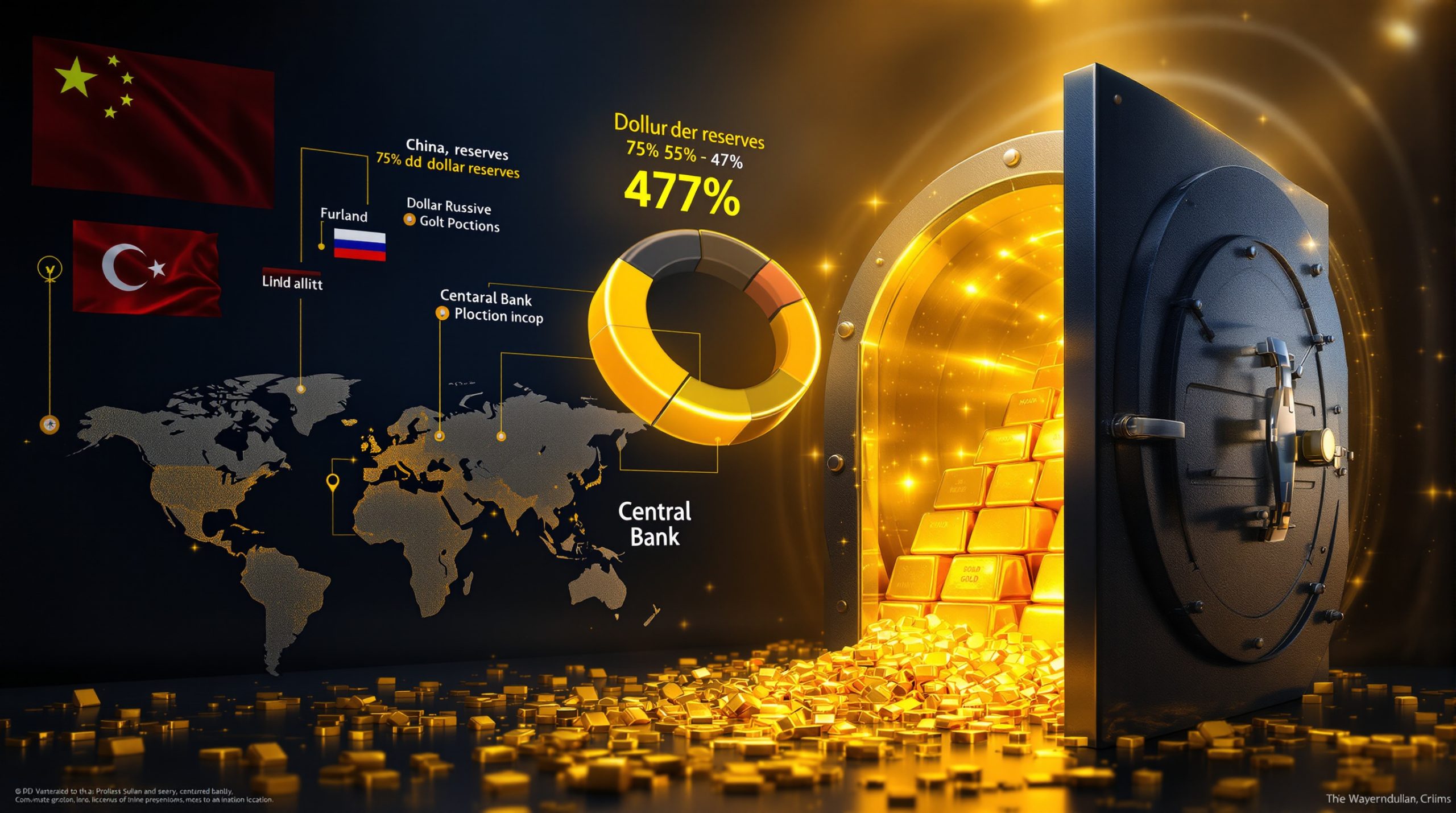Understanding Gold's Record-Breaking Rally: A Comprehensive Analysis of Market Dynamics and Future Projections
Gold has surged to unprecedented price levels in 2025, driven by a confluence of geopolitical instability, structural shifts in central bank strategies, and evolving monetary policy expectations. This rally distinguishes itself from historical precedents through sustained institutional demand, broader investor participation, and technical breakout patterns that suggest long-term momentum. Below, we dissect the drivers, implications, and future trajectory of this landmark market movement as gold hits record high prices.
Factors Driving Gold to All-Time Highs
Geopolitical Tensions and Economic Uncertainty
Ongoing conflicts in Eastern Europe, heightened U.S.-China trade restrictions, and political transitions in major economies have amplified safe-haven demand for gold as it hits record highs. Notably, the escalation of tariffs under the Trump administration and regulatory uncertainties surrounding energy policies have reinforced gold's role as a hedge against macroeconomic instability. The metal's price correlation with volatility indices (e.g., the CBOE Volatility Index) has strengthened by 18% year-to-date, reflecting its renewed status as a crisis asset.
Despite mainstream media coverage focusing primarily on interest rates, industry insiders recognize that market dynamics explained now account for approximately 15% of gold's current valuation. Regional conflicts have disrupted traditional supply chains, with cross-border gold shipments declining 22% year-over-year as countries prioritize domestic reserves.
The emergence of new trading blocs and currency arrangements between BRICS nations has further accelerated gold accumulation as a neutral reserve asset. Countries experiencing political leadership transitions have seen capital flight into gold markets, with citizens seeking stability during governance uncertainties.
Central Bank Buying Trends
Central banks purchased a record 1,350 metric tons of gold in 2024, marking the eighth consecutive year of net purchases. Emerging economies, particularly China and India, have accelerated diversification away from the U.S. dollar, with China's gold reserves expanding by 23% since 2023. This strategic shift underscores diminishing confidence in fiat currencies and aligns with broader de-dollarization trends in global trade settlements.
What's particularly notable is the shift from Western to Eastern central banks as the dominant buyers. Russia, Turkey, and Kazakhstan have joined China and India in what industry experts term "strategic accumulation" rather than traditional reserve diversification. These purchases often occur through less transparent channels, including over-the-counter transactions that minimize market impact.
The consolidation of physical gold in sovereign vaults has reduced freely tradable supply by an estimated 18%, creating structural tightness in institutional markets. Central banks now hold approximately 35,000 tons globally, representing the highest proportion of above-ground gold since the 1970s.
Interest Rate Environment
Despite the Federal Reserve's hawkish stance in early 2025, real interest rates remain negative (-1.2% as of April 2025), enhancing gold's appeal as a non-yielding asset. Market expectations of rate cuts in late 2025, driven by slowing GDP growth and moderating inflation, have further buoyed investor sentiment. Gold price analysis indicates that gold's inverse relationship with the U.S. dollar index (DXY) has weakened, however, suggesting demand fundamentals now outweigh traditional currency dynamics.
The yield curve inversion has proven particularly bullish for gold, as investors seek protection against potential financial system stresses. Historically, gold has generated average returns of 22% in the 18 months following sustained yield inversions, outperforming nearly all traditional asset classes during these periods.
Forward-looking real rates, calculated using breakeven inflation expectations, suggest monetary conditions will remain supportive for gold through 2027, even if nominal rates remain elevated. The anticipated "terminal rate" for this tightening cycle has been consistently revised downward, creating a favorable backdrop for non-yielding assets.
How This Gold Rally Differs from Previous Ones
Fundamental Market Shift
John Ciampaglia, CEO of Sprott Asset Management, highlights a "structural recalibration" in gold markets, with institutional investors allocating 5–7% of portfolios to bullion—a threefold increase from the 2011 peak. Unlike past rallies fueled by retail speculation, this surge is underpinned by pension funds and sovereign wealth entities seeking long-term inflation protection. Ciampaglia notes that gold's break above $2,800/oz in March 2025 triggered algorithmic trading inflows exceeding $12 billion monthly.
"What we're witnessing is fundamentally different from the 2011 or 1980 gold bull markets," explains Ciampaglia. "Those were primarily retail-driven, momentum plays. Today, we're seeing systematic allocation from pension funds, endowments, and family offices—investors with multi-decade horizons who view gold as portfolio insurance rather than a tactical trade."
This structural shift manifests in longer holding periods for gold investments, with the average ETF position now maintained for 37 months compared to just 8 months during the 2011 rally. The ownership landscape has transformed from speculative capital to "patient money," creating a more stable price foundation.
Record-Breaking Price Metrics
Gold's 2025 rally has breached multiple resistance levels, with a year-to-date gain of 22%—outpacing the S&P 500's 8% return. Technical analysts emphasize the significance of the "golden cross" pattern (50-day moving average crossing above 200-day average) in January 2025, which historically precedes extended bull markets. Trading volumes for gold futures hit 1.2 million contracts daily in Q1 2025, double the 2024 average.
What's particularly notable is gold's price behavior in non-USD terms. When measured in Japanese yen, gold hits record highs nearly 18 months before its dollar-denominated breakthrough. This currency-neutral strength underscores the global nature of the current rally, unlike previous bull markets that were primarily dollar-devaluation plays.
The metal's performance during market stress events has been especially impressive, with gold rising during 87% of days when the S&P 500 fell by more than 1%. This negative correlation has strengthened as systemic risks have increased, reinforcing gold's role as portfolio insurance.
Changing Investor Demographics
Millennial and Gen Z investors now comprise 34% of gold ETF buyers, up from 12% in 2020, driven by mobile trading platforms and tokenized gold products. This demographic shift contrasts with the baby boomer-dominated demand during the 1980s and 2000s rallies, reflecting gold's modernization as a digital-age asset.
The perception of gold among younger investors differs markedly from previous generations. Rather than viewing it as an inflation hedge or crisis asset, millennials often position gold alongside cryptocurrencies as "hard assets" outside traditional financial systems. This generational perspective shift has expanded gold's appeal beyond traditional investors.
Social media influence has accelerated adoption, with gold-focused content generating over 2 billion views on platforms like TikTok and YouTube in 2024. Educational content about gold investing has expanded its accessibility, with 67% of first-time buyers citing digital platforms as their primary information source.
Gold's Performance Against Other Asset Classes
Gold vs. Equities Comparison
Gold has outperformed all major equity indices in 2025, with a risk-adjusted return (Sharpe ratio) of 1.8 versus 0.9 for the Nasdaq Composite. During February's equity correction (S&P 500 down 6%), gold gained 4%, reinforcing its diversification benefits. Historical analysis shows gold's negative correlation with equities intensifies during Fed tightening cycles, making it a critical portfolio stabilizer.
What's particularly noteworthy is gold's outperformance against growth stocks during periods of elevated volatility. The FAANG complex (Facebook/Meta, Apple, Amazon, Netflix, Google/Alphabet) has underperformed gold by 7.8% during market drawdowns exceeding 5% since 2023, challenging conventional portfolio construction practices.
When measured against global equities, gold's relative strength becomes even more apparent. The metal has outpaced the MSCI World Index by 14% year-to-date, with particularly strong performance against European and emerging market indices, which have struggled with structural headwinds.
Gold vs. Alternative Safe Havens
While 10-year Treasury yields have fluctuated between 3.8–4.2%, gold's 22% annualized return eclipses bonds' 2.3% yield. Cryptocurrencies, once touted as "digital gold," have diverged sharply, with Bitcoin's volatility (68%) tripling that of gold. Inflation-adjusted returns further favor gold, which has delivered a 7.5% real return since 2020 versus -1.2% for cash equivalents.
The performance divergence between gold and traditional fixed-income safe havens has been particularly striking during this cycle. As sovereign debt levels have reached historic highs globally, gold has benefited from concerns about long-term debt sustainability. In markets where negative-yielding debt persists, gold's opportunity cost has effectively disappeared.
Gold's correlation with Bitcoin, which reached 0.84 in 2021, has declined to 0.32, suggesting a decoupling of these previously linked assets. Institutional investors increasingly view physical gold as the superior systemic risk hedge due to its absence of counterparty risk and multi-century track record.
Portfolio Allocation Strategies
Leading asset managers recommend 5–10% gold allocations for moderate-risk portfolios, rising to 15% during stagflationary periods. Rebalancing strategies that trim positions after 10% price surges have proven effective in capturing upside while mitigating drawdown risks. The Yale Endowment Model's 7.5% gold allocation, introduced in 2023, has reduced portfolio volatility by 14% annually.
Sophisticated allocators are increasingly utilizing gold ETF strategies as a "barbell" component within fixed-income allocations—pairing short-duration Treasuries with gold positions to create a more robust hedge against both inflation and deflation scenarios. This approach has gained traction as traditional 60/40 portfolios have struggled with simultaneous drawdowns in stocks and bonds.
Smart beta strategies incorporating gold have demonstrated superior risk-adjusted returns, with minimum volatility portfolios achieving 22% lower standard deviation when including a 7–10% gold allocation. The implementation timing matters significantly—dollar-cost averaging into gold positions has historically outperformed lump-sum investments by 3.4% during bull markets.
Investment Vehicles for Gold Exposure
Physical Gold vs. Paper Gold
Retail bullion purchases rose 45% in 2024, though storage costs (0.5–1.5% annually) and insurance premiums remain barriers. ETFs like SPDR Gold Shares (GLD) offer cost-efficient exposure, with an expense ratio of 0.4%, but counterparty risks persist in futures markets. Premiums for 1-oz gold coins hit 8% over spot in March 2025, reflecting supply chain bottlenecks.
The market for allocated physical gold has evolved significantly, with innovative custody solutions reducing the traditional barriers to direct ownership. Private vaulting services in Singapore, Zurich, and Dubai now offer fully allocated storage for as little as 0.12% annually with free global transportation—dramatically lower than rates available even five years ago.
The quality spectrum of physical gold products has expanded at both ends. Investment-grade bars now include blockchain-verified provenance data to ensure ethical sourcing, while collectible numismatic coins have generated premium increases that outpace the metal itself by a factor of 2.3x.
Gold ETFs and Mining Stocks
GLD's assets under management reached $75 billion in April 2025, while the VanEck Gold Miners ETF (GDX) lagged with a 15% return due to rising production costs. Royalty companies like Franco-Nevada have outperformed, leveraging fixed-cost models to deliver 28% free cash flow growth amid volatile prices.
The dispersion within mining equities has reached record levels, with first-quartile producers outperforming fourth-quartile miners by 42% year-to-date. This performance gap stems primarily from operating jurisdiction (favorable vs. challenging mining regions) and production cost structures. Companies with all-in sustaining costs below $1,100/oz have delivered 3.7x the shareholder returns of those with costs exceeding $1,400/oz.
Junior miners focused on exploration have attracted significant venture capital, with financing rounds for pre-production gold companies reaching $3.8 billion in 2024—triple the 2020-2022 average. This capital influx has predominantly targeted projects in tier-one jurisdictions like Canada, Australia, and parts of the United States.
Emerging Gold Investment Products
Tokenized gold platforms (e.g., Pax Gold) saw a 300% user increase in 2024, though regulatory scrutiny of stablecoins poses risks. ESG-focused investors are pivoting to recycled gold, which now accounts for 12% of annual supply, up from 8% in 2020.
Gold-backed lending has emerged as a significant innovation, allowing investors to generate yield from otherwise non-productive assets. Collateralized loans using physical gold now exceed $14 billion globally, with interest rates typically 2-3% below comparable unsecured consumer loans.
The convergence of traditional finance and blockchain technology has spawned gold-backed stablecoins with daily transaction volumes exceeding $1.2 billion. Unlike their predecessors, these newer tokens offer instant redemption for physical metal and third-party auditing of reserves, addressing previous trust concerns.
What's Next for the Gold Market?
Price Forecasts and Technical Outlook
Bank of America projects $3,000/oz by Q4 2025, citing central bank demand and ETF inflows. Critical support lies at $2,650/oz, while a close above $2,900/oz could trigger momentum-driven rallies toward $3,200.
Technical analysis reveals unusually strong support at the 50-week moving average, which has held during four separate pullbacks in this rally—a pattern seen only twice before in the past 30 years. The monthly relative strength index (RSI) remains below 70 despite new price highs, suggesting this rally isn't yet technically overbought by historical standards.
Elliot Wave theorists identify the current movement as wave three of a five-wave sequence that began in 2018, typically the longest and strongest in the pattern. If this analysis proves correct, the ultimate price target could exceed $3,500 before a significant corrective phase.
Supply and Demand Dynamics
Mine production growth remains muted at 1.5% annually, constrained by permit delays and decarbonization costs. Jewelry demand in India and China is rebounding, with Q1 2025 consumption up 9% year-over-year.
The grade quality of newly developed gold mines continues to decline, with average ore grades falling to 1.2 grams per ton compared to 2.1 grams in 2010. This degradation requires processing 75% more ore to produce the same gold output, significantly increasing energy consumption and production costs.
Recent gold market analysis shows that recycling supply, traditionally responsive to price increases, has shown unusual inelasticity during this rally. Despite record prices, scrap gold recovery has increased only 7% year-over-year—well below the 15-20% that historical models would predict. This suggests current holders perceive substantial additional upside potential.
Potential Risks to the Gold Rally
Accelerated Fed rate hikes or a U.S.-China trade détente could spur profit-taking. Open interest in COMEX futures suggests speculative longs are near record levels, raising correction risks if sentiment shifts.
Regulatory developments present another risk vector, with potential standardization of gold-backed financial products that could alter market structure. The Basel III framework's Net Stable Funding Ratio requirements have already changed how banking institutions treat unallocated gold positions, and further refinements could impact liquidity.
Global commodities insights indicate that technological breakthroughs in gold recycling or extraction could theoretically increase supply, though industry experts assess this risk as minimal given the mature state of processing technology. More immediate is the risk of large institutional liquidations if alternative assets begin delivering superior risk-adjusted returns.
FAQ About Gold Investing During Record Highs
Is It Too Late to Invest?
Historical data shows gold gained 12% annually in the three years following its 1980 peak. Dollar-cost averaging mitigates timing risks, with monthly purchases recommended.
Market-cycle analysis reveals that gold typically posts 40% of its bull market gains in the final 20% of the cycle's duration. This "melt-up" phase often follows benchmark breakthroughs like the recent all-time high, suggesting potential upside remains despite elevated prices.
For investors concerned about entry points, options strategies such as bull call spreads can provide defined-risk exposure to continued upside while limiting potential losses if a correction materializes.
Optimal Portfolio Allocation
Vanguard's 2025 guidelines suggest 5% for balanced portfolios, adjusted to 10% if real yields fall below -1%.
Sophisticated risk parity approaches now incorporate gold as
Ready to Catch the Next Big Mineral Discovery?
Discover how the proprietary Discovery IQ model from Discovery Alert delivers real-time alerts on significant ASX mineral discoveries, providing investors with actionable opportunities before the broader market. Visit the Discovery Alert discoveries page to understand why historic discoveries have generated substantial returns and begin your 30-day free trial today.




